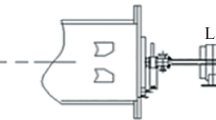Abstract
Purpose
This paper presents the development and implementation of a microtron-based setup for solid-state sample irradiation.
Methods
The fabrication of microtron components that extract 6 MeV electrons is detailed, enabling detailed studies of energy-dependent radiation effects.
Results
Experimental findings have led to a precise map** of accelerated electron flux density, and subsequently, the establishment of uniform irradiation zones and real-time dose absorption control. Titanium carbide samples were irradiated using the bremsstrahlung of electrons from the microtron.
Conclusion
Calculations of absorbed doses from an extended bremsstrahlung source were conducted, considering key factors such as sample geometry and physical properties.








Similar content being viewed by others
Notes
From graph 25 in [19], for tungsten, \(K \approx 0.7\) for E0 = 6 MeV and \(K \approx 0.75\) for E0 = 10 MeV.
References
G. Wu, M. Zhai, M. Wang (eds.), Radiation Technology for Advanced Materials: From Basic to Modern Applications (Academic Press, Cambridge, 2019)
R.B. Miller, Electronic Irradiation of Foods: An Introduction to the Technology, 1st edn. (Springer Science & Business Media, New Mexico, 2006)
R. Pacelli, L. Mansi, Eric Hall and Amato J, Giaccia: Radiobiology for the radiologist, 6th edn. Eur. J. Nucl. Med. Mol. Imaging 34, 965 (2007)
R. Appleby, G. Burt, J. Clarke, H. Owen, The Science and Technology of Particle Accelerators, 1st edn. (Taylor & Francis, Boca Raton, 2020)
M.R. Cleland, CERN Accelerator School/Small Accelerator Course (Zeegse, The Netherlands, 2005), p.24
A.G. Chmielewski, M. Haji-Saeid, Radiation technologies: past, present and future. Radiat. Phys. Chem. 71, 17 (2004)
A.G. Chmielewski, M. Al-Sheikhly, A.J. Berejka, M.R. Cleland, M. Antoniak, Recent developments in the application of electron accelerators for polymer processing. Radiat. Phys. Chem. 94, 147 (2014)
O. Barbalat, Applications of Particle Accelerators (CERN, Geneva, 1990)
S. Machi, Trends for electron beam accelerator applications in industry. Rev. Accel. Sci. Technol. 04, 1 (2011)
D. Abshire, M.K. Lang, Seminars in Oncology Nursing (Elsevier, Amsterdam, 2018), pp.151–157
W.H. Hunt, Nanomaterials: Nomenclature, novelty, and necessity. JOM 56, 13 (2004)
G.S. Was, Fundamentals of Radiation Materials Science: Metals and Alloys, 2nd edn. (Springer, New York, 2016)
M. J. Berger, J. S. Coursey, and M. A. Zucker, ESTAR, PSTAR, and ASTAR: Computer Programs for Calculating Stop**-Power and Range Tables for Electrons, Protons, and Helium Ions (version 1.21). NIST Standard Reference Database 124 (1998).
S. Khasanov, A. Safarov, A. Safarov, R. Suleymanov, K. Norboev, S. Khadka, A setup for irradiation of biological samples based on accelerated electrons. Nucl. Instrum. Methods Phys. Res. B: Beam Interact. Mater. Atoms 525, 13 (2022)
S. Khasanov, R. Suleymanov, A. Safarov, A. Safarov, H.M. Tedila, R. Muratov, Calculation of exposure and absorbed dose at irradiation samples by electron bremsstrahlung. Radiat. Phys. Chem. 188, 109651 (2021)
L.I. Schiff, Energy-angle distribution of thin target bremsstrahlung. Phys. Rev. 83, 252 (1951)
Y.N. Burmistenko, Photonuclear Analysis of the Substance Composition (Energoatomizdat, Moscow, 1986), p.24
L. Katz, A.G.W. Cameron, The solution of x-ray activation curves for photonuclear cross sections. Can. J. Phys. 29, 518 (1951)
H.W. Koch, J.W. Motz, Bremsstrahlung cross-section formulas and related data. Rev. Mod. Phys. 31, 920 (1959)
A.V. Ardashnikov, S.N. Goldin, S.M. Nikolaev, Protection from Radioactive Radiations (Metallurgizdat, Moscow, 2008)
Acknowledgements
Shakhboz Khasanov wishes to thank the Chinese Academy of Science (CAS) and The World Academy of Science (TWAS) for providing financial support by means of the 2019 CAS-TWAS President’s Fellowship Programme (No. 2019CTF123).
Author information
Authors and Affiliations
Corresponding author
Ethics declarations
Conflict of interest
The authors declare that they have no known competing financial interests or personal relationships that could have appeared to influence the work reported in this paper.
Rights and permissions
Springer Nature or its licensor (e.g. a society or other partner) holds exclusive rights to this article under a publishing agreement with the author(s) or other rightsholder(s); author self-archiving of the accepted manuscript version of this article is solely governed by the terms of such publishing agreement and applicable law.
About this article
Cite this article
Khasanov, S., Su, Y., Suleymanov, R. et al. A setup and analytical dose calculation model for solid-state sample irradiation using a microtron type e-beam accelerator. Radiat Detect Technol Methods (2024). https://doi.org/10.1007/s41605-024-00483-8
Received:
Revised:
Accepted:
Published:
DOI: https://doi.org/10.1007/s41605-024-00483-8




